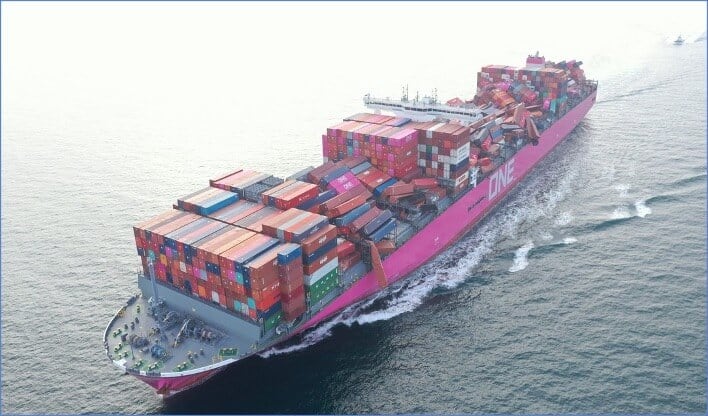Issue 10: European Shippers Call for Contract Violation Investigation

Hello, everyone, and welcome to the first Legacy Monthly Shipment of 2021!
2020 certainly put us to the test, which is why we’re all the more excited to see what this new year has in store. It’s already shaping up to be a better year, with some of the strongest job growth predictions on record, and GDP growth expected to be somewhere between 3.5%–6.4%. At the very least, with vaccine efforts well underway, we could be reunited with family and friends as soon as Spring 2021!
With so much to look forward to, let’s get the ball rolling with today’s stories.
Today’s Shipment:
- An update on the ONE Apus incident.
- Maersk partners with stakeholders to address port congestion.
- A bullish year for carriers could spell trouble for shippers.
- European shippers call for investigation into ocean carrier contract violations.
- The Airbus A321 gains momentum in the passenger-to-freight conversion market.
UPDATE
Discharging Operations Remain Underway in Aftermath of ONE Opus Incident
We kick off this month’s newsletter with an update on the ONE Apus incident, which we covered in our previous issue. A quick refresher: On November 30, 2020, the ONE Apus container ship lost nearly a quarter of its cargo en route from Yantian, China, to the Port of Long Beach, California, due to inclement weather. Since the vessel arrived in Kobe, Japan, on December 9 (where it was rerouted following the incident), surveyors have been hard at work assessing the damage.
As of January 8, 2021, a total of 232 containers had been removed from the vessel. Surveyors report that it’ll take some time — as much as several more weeks — to complete discharging operations. Drone footage of the vessel limping back to Japan for rework provides much-needed insight into the complexity of the damage. The precarious positioning of the containers calls to mind a tower of Jenga blocks, which the cargo team must carefully unload in order to avoid collapsing the pile and causing further damage to the cargo or the vessel. This operation is especially fraught given that many of the containers house dangerous goods; 64 of the 1,816 containers lost during the incident were found to contain fireworks, batteries and liquid ethanol.

According to an official statement from Ocean Network Express (ONE):
“The careful removal of the dislodged units under a schedule formulated by stowage planners is expected to take over a month with safety the number-one priority. Once unloaded, each will be assessed and, when the discharge of cargo is complete, there will be a full assessment of damage to the vessel, and subsequent repairs.”
Although ONE is likely aware of the contents of each container, it has been slow to share that information with shippers, leading to further frustration. Why, exactly, we cannot say for sure, though it is possible that the carrier would prefer to make a larger official statement rather than dole out information in small batches. Either way, shippers have been left guessing for weeks whether their cargo is salvageable and when it will be accessible; we wouldn’t be surprised if this prompted calls from shippers for greater visibility in the aftermath of future incidents.
For our part, the Legacy team recommends that our clients behave as though their cargo is lost and work with suppliers to generate new inventory, if they haven’t already done so. Consider this cargo new inventory once it becomes available. We also advise that all of our clients evaluate insurance coverage against future risks. Though infrequent and rarely of this magnitude, marine and other transportation accidents do happen, so it’s best to be prepared. If you’d like to explore insurance options, or even reevaluate your current provider, Legacy can help you understand your options and costs.
BRIEF
Maersk Teams up with Stakeholders to Resolve Ongoing U.S. Port Congestion Issues
Continuing with the theme of updates, in last month’s Shipment, we discussed high container import volumes in the Ports of Los Angeles and Long Beach. In an effort to reduce congestion in these and other U.S. ports, A.P. Moller-Maersk has held meetings with the Federal Maritime Commission (FMC), the Agriculture Transportation Coalition and the Harbor Trucking Association.
These meetings come hot on the heels of an FMC investigation into port congestion, which prompted two FMC commissioners to write a letter to the World Shipping Council. Maersk has yet to reveal any details about the substance of these meetings, or any additional plans on how it intends to address the issue at hand. That said, the shipping company did announce that it intends to improve the route of dual transactions at the APM Terminals’ Pier 400 in the Port of LA in a move consistent with the Port of Long Beach’s recent effort to increase dual transactions.
Given that Maersk has long been a market leader in driving supply chain efficiency from a carrier perspective, there’s hope that these conversations will prompt real action. Ultimately, it’s all about equipment positioning and enabling exporters to source equipment more efficiently. Import glut and congestion have proven a major obstacle to exporters, as many carriers will not release equipment to them, instead opting to return empty containers to Asia as quickly as possible to support import demand. Carriers typically prefer to run loads to the West Coast, unload and then return to Asia for reload; the same is done for equipment moving into the Midwest. Directing empties to Midwest shippers generates low revenue relative to import — and turns equipment slower.
We recommend that any exporters experiencing these challenges talk to their freight forwarder and non-vessel operator (NVO) partners, as they have ability to look at the market holistically and evaluate extended options. For shippers talking to carriers, there’s no time like the present to evaluate a freight forwarder or NVO; Legacy can help you get started. In the meantime, follow the news on Maersk’s efforts — results will take some time, but we expect new solutions to evolve.
OUTLOOK
Analysts Anticipate Bullish Year for LTL Carriers, Putting Shippers in a Difficult Position
In spite of COVID-related disruption, leading less-than-truckload (LTL) executives and analysts alike have high hopes for the sector in 2021 and predict a bullish year for demand. This news likely comes as little surprise to Shipment readers, as we’ve closely followed and reported upon ever-contracting capacity and increasing demand for the better part of a year now.
While this optimistic outlook means it is — in the words of Satish Jindel, principal of SJ Consulting — “a wonderful time to be in the LTL sector,” it translates to higher transport costs for shippers. Financial services provider UBS anticipates rate increases across all road sectors, with mid-to-high single digit increases in the LTL segment.
The LTL market on the whole is similar to the ocean freight market in that there are fewer carriers — there are approximately 25 major LTL carriers in the U.S. — and more concentrated capacity. This concentrated capacity enables the industry to better manage pricing. Carriers are rolling out increases of 5% to 9% in 2021 and, unfortunately for shippers, they’ll get it. The economic rebound anticipated for 2021 will continue to fuel high volumes of retail shippers, which benefits carriers. In addition to LTL carriers, truckload carriers are also expected to see a stronger market. Though truckload is a far more fragmented market, rising demand forecasted for 2021 will driver higher pricing because capacity will be slower to return and grow.
With rates increasing for North American transportation in 2021, what’s a shipper to do? The best course of action is to be as carrier-friendly as possible and to take steps to become a shipper of choice. A few tips to help you get started:
- Pay carriers quickly and accurately.
- Efficiency is key, so don’t keep drivers waiting.
- Remember the Golden Rule: Treat drivers and carrier staff as you would want to be treated.
- Try to be flexible; work with carriers on pickup and delivery times or general operational needs.
- Offer greater visibility by planning and giving carriers lead time; if you anticipate changes in your business, let carriers know as soon as possible so that they have time to adapt.
- Communicate with carriers early and often.
- Work closely with carriers to understand how you can help them drive efficiency, while still meeting your shipping demands.
In addition to becoming a shipper of choice, you might also benefit from exploring third-party options, such as a freight broker. In most cases, freight brokers have more volume and more carrier relationships than independent shippers, which means they can provide more options in the market. Brokers can help shippers enhance service, while simultaneously improving cost and capacity for LTL, truckload and rail.
NEWS
European Shippers Call for Investigation into Unreasonable Ocean Carrier Practices
In a joint letter to the Competition Directorate of the European Commission, the European Freight Forwarders Association (CLECAT) and the European Shippers’ Council (ESC) have accused ocean carriers of violating existing contracts, establishing unreasonable conditions concerning the acceptance of bookings and setting rates far in excess of those agreed to in contracts.
In light of these accusations, which “demonstrate the damage carriers’ [behaviour] is causing to trade growth at a time of economic recession,” CLECAT and ESC have called upon the Commission to launch a formal investigation.
“All sort of industries are impacted but some [of] it may depend on the margins companies have; the lower the margins and the lower the costs of the products the higher the shipping costs,” said Nicolette van der Jagt, Director General of CLECAT, in an email to Supply Chain Dive. “For example, we were contacted by the European associations representing importers of dried fruits, nuts, etc. Several of their members have advised that their customers intend to cancel contracts next year as this destroys the margin they may have been able to earn.”
There can be no doubt that 2020 proved challenging for all those involved; for their part, carriers have acknowledged shipping challenges, but claim that their hands are tied. The World Shipping Council, which consists of ocean carriers, has stated that “Vessel capacity is fully utilized, and little excess is available,” however, that it expects the current shipping environment to stabilize with time.
This situation is a prime example of the global demand for capacity out of Asia. European and U.S. shippers alike have experienced rising costs and service deadlines in sea freight for most of 2020; European shippers have also experienced these in the Asia-to-Europe rail market through Eastern Europe. Digital ocean freight rates specialist, Xeneta, recently reported that trans-Pacific Asia to Europe rates are at record highs, and that there are surcharges of over $1,000 — that’s a 20% increase in rates this month, alone.
This is a global problem, one that points to strong consumer demand, more consumer spending on products rather than services and some manufacturing rebound. It is also a result of the industry’s evolutionary trend toward fewer carriers due to M&A activity and carrier bankruptcy. We’re looking at a finite market, even globally, which means that carriers are becoming more disciplined at managing market pricing.
We expect the market to soften somewhat after Chinese New Year, though rates will remain strong. Carriers have learned from past mistakes and will work hard to avoid the cannibalization of rates that has occurred in years past. Post-Chinese New Year, shippers should start talking to their carriers, as well as NVOs and freight forwarders, to evaluate options for 2021. As already stated, NVOs and freight forwarders can offer a wider variety of carrier options, as well as more service and solutions than asset-based carriers, alone.
REPORT
Titan Airways Becomes Second Airline to Operate Converted Airbus A321 Freighter
Last week, Titan Airways received the first of three Airbus A321 converted passenger freighters, making it just the second carrier to add the aircraft to its fleet. The A321, which began initial production last fall, boasts containerized loading in the belly hold, a gross payload of over 61,000 pounds and built-in weight distribution software, making it a competitive alternative to the Boeing 737-800.
A321 conversions could prove a major boon to shippers in the air cargo market, which has been strapped for capacity. Demand for A321 passenger-to-freighter aircraft conversions is so high, in fact, that Elbe Flugzeugwerke — the joint venture between Airbus and ST Engineering responsible for its production — has established a conversion site in Guangzhou, China, and has plans to expand to the U.S. and Germany.
Qantas Freight was the first to operate an A321 passenger-to-freight conversion; Global Crossing Airlines and SmartLynx Airlines are also both on track to lease 10 and 2 converted A321 freighters, respectively, from Luxembourg-based aircraft trading and leasing company Vallair.
The A321’s popularity makes sense — it’s able to support higher volumes of containerized air cargo, loosening the cargo limitations associated with other aircraft. Now that it has been identified as a viable option for passenger-to-cargo conversion in regional freight markets, we expect to see it adopted by a growing number of cargo carriers. We even believe that adoption of the A321 will become a longer-term opportunity — post-COVID — for regional air cargo markets. Watch to see if carriers like FedEx and UPS or regional Asian air cargo players adopt this aircraft.
The practice of converting passenger aircraft into cargo aircraft is becoming more sophisticated. We can’t help but wonder whether aircraft manufacturers will take notice and start to produce more flexible models that can be converted from passenger aircraft into cargo aircraft and back again in order to seize more profit opportunities. Ultimately, this points to more capacity for air cargo being added back into the system, which is great news for shippers, given that air freight rates in the trans-Pacific skyrocketed up to $15 per kilo in Q2 2020. On top of the many other things to look forward to in 2021, shippers are also looking at the possibility of improved capacity and reduced costs.
What are you hopeful for in 2021? Any big plans for your company? We love hearing from our readers, so send us an email and let us know!
For more news, as well as coverage of the latest trends and tips on how to optimize your supply chain, check out our blog or resource center, or chat with one of our specialists.
Until next month, this is Legacy, over and out.
Get Insights. Stay Ahead.
Get the latest news and insights via email on warehouse improvement, transportation optimization, labor strikes and international shipping rate changes.Popular Posts
Search Posts
-
2024 Q1 Freight Landscape: Trends, Challenges, and Predictions
As the first quarter of 2024 comes to an end, here are some observations over the past few months as well as predictions about the trucking...
+ Read more -
Baltimore Bridge Impact Assessment – Update
Following the recent Baltimore Bridge collapse and subsequent port closures, we want to keep our customers informed about the situation and...
+ Read more -
Global Momentum Builds for Charge on Global Shipping Sector’s CO2 Emissions
A growing coalition of 47 countries, including key players like the European Union, Canada, Japan, and various Pacific Island nations, is...
+ Read more










